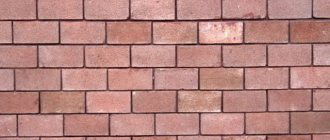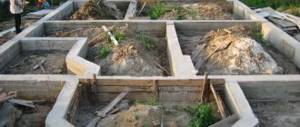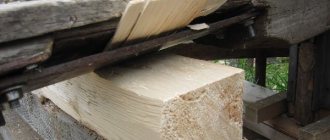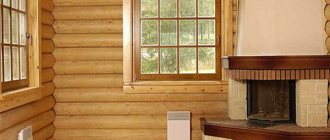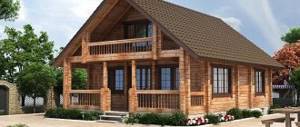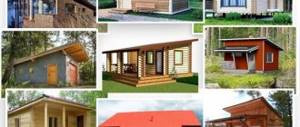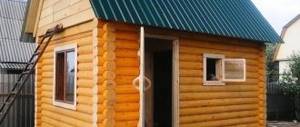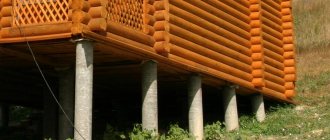Stylistics and beauty
From time immemorial, bathhouses in Rus' were built as a separate house, the walls of which were assembled from logs. Now you can also order a log house for yourself, but not necessarily. Nothing prevents the homeowner from using some modern construction material, either cheaper or more accessible...
Even rolled metal or a concrete monolith... and then buy profiled lumber for cladding and make the bathhouse indistinguishable from a natural log house. If you look at a photo of a block house finishing a bathhouse, you will see that this material very realistically imitates the appearance of a rounded log, and this effect can be achieved both outside and inside.
Choose the models that you like best in terms of thickness and width, texture - and go ahead.
Finishing a bathhouse with a blockhouse outside
Finishing a bathhouse with a blockhouse from the inside
Relief surface of blockhouse walls
Varieties
Depending on the quality and performance characteristics, the block house can be divided into 4 classes:
- C is the lowest quality class. Finished panels may have cracks, chips, knots, and unevenness.
- B - second quality class. The panels are smoother and cleaner, but there are cracks and darkening of the wood.
- A - high-quality panels that undergo additional polishing at the enterprise. Sometimes there may be large knots.
- Top class. Surfaces are brought to perfect condition. The panels are used for cladding walls inside the building.
When purchasing a block house, you need to check the humidity level. It is not recommended to use damp or too dry panels. They will quickly lose strength and become unusable.
Eco-friendly and natural
Block house planks are made by milling blanks from solid wood. In other words, the products do not contain any binders (they are usually the source of harmful volatile compounds), no glue is used, and no special impregnation is performed in the workshops. By creating cladding, a person will receive 100 percent natural walls that emit only useful substances, saturate the air with pleasant aromas, and emit the unique energy of a healthy forest.
Experts note that it is better not to use coniferous lumber in the steam room due to its resin content. Whereas for the facade, for the washing room, for the rest room and for the locker room - spruce or pine are suitable without restrictions.
Meanwhile, many users use inexpensive coniferous material here, and finishing the bathhouse with a block house inside (where there are no such temperatures as in a sauna) does not cause any trouble. True, for this it is better to buy a high-grade product, with a clean, smooth surface, without large tars, and with a small number of knots. Category “A” will be just right here, “Extra” is also suitable.
Some adjustments to the idyll can be made by paints and varnishes, without which the wood cannot be used normally. On the street side, you can (and should) use the most effective treatment compounds - antiseptics, fire retardants, protective and decorative agents that form a “film.” But the interior decoration of a block house bathhouse, especially in the steam room itself, requires special impregnations that are safe when heated and do not affect the natural texture and color of the wood. These can be specialized oils and waxes, a good solution is “KRASULA for baths and saunas”, which protects the walls from contamination, from microbes and fungus; gives the surfaces water-repellent properties - but allows the wood to breathe and practically does not change the appearance of the blockhouse.
Blockhouse for a bathhouse
Description and production technology of the material
Block house is an environmentally friendly material used for external and internal decoration of buildings. Treatment:
- The edges of the log are trimmed to produce a block house.
- The central part is used to make boards and timber.
If the production is private, the material is made from edged boards using special equipment - a four-sided milling machine.
In the manufacture of panels, wood with a moisture content of no more than 13% is used. It will not dry out or crack due to temperature changes.
Insulating properties
The most important condition for the correct and stable operation of any bathhouse/sauna is high temperature. To heat the steam room to +60 degrees or more, you need a stove. But no matter how productive the heat generator is, energy must be saved. This is especially difficult to do in winter, especially in harsh climates. As practice shows, log houses do not have sufficient resistance to heat transfer, unless they are assembled from logs 35-40 centimeters in diameter.
Therefore, the most correct solution would be to build walls immediately using warm materials, with the required thickness. For example, you can use blocks made of aerated concrete or shell rock. Then these enclosing structures are hung with a frame made of edged timber and sheathed with wood - a blockhouse.
Insulation occurs not simply due to the porosity of the supporting material, but also with the help of insulation materials placed between the racks of the wall frame. The role of reflective films is important (they are attached under the casing in the steam room), which, in addition to other functions, return radiant energy to the room.
It is interesting that an initially wooden (log or profiled beam) bath house can also have a block house on the facade. A log house that is insulated with mineral wool and then lined with a block house is a justified technological necessity.
An equally effective (and perhaps the best in this regard) type of free-standing bathhouse is a frame structure, in which thick insulation for the bathhouse is installed directly inside the walls. The house block here is attached to the racks of the supporting frame; it acts both as a protective casing for the entire wall pie and as an additional insulating layer. It is necessary to take into account that the blockhouse, unlike eurolining, has a very impressive thickness (28, 36, 45 millimeters), and this has a very positive effect on the thermal insulation capabilities of the cladding. Needless to say, this cladding also works great as an additional soundproofing layer.
Installation of a block house on a bathhouse
We should not forget that blockhouse planks, being a modern profiled material, are equipped with a tongue and groove. By assembling the cladding “in a lock”, we can not only use a hidden installation method, but also get rid of blowing, since there are no through gaps after installation.
How is the lining done inside the bathhouse?
A sauna built with your own hands is a place where you can rest and relax, and it is also a source of pride. But, in addition to its functional purpose, the bathhouse must have an attractive appearance, and you need to know what material to cover the outside of the bathhouse with. Traditionally, the bathhouse is lined with wood, but today there are many other designs.
A wooden bathhouse can be treated with special compounds and finished with your own hands with the greatest economic benefit. This finishing method is considered the most practical. Finishing using impregnation is carried out in three stages, and the material itself has the following properties:
- antiseptic;
- fire protection;
- protective, reducing the impact of environmental factors.
Impregnation of the bath is carried out in any case, and compositions for treating the structure are quite cheap. After such finishing, the facade of the bathhouse will be able to retain its original appearance for a long time.
This finishing option can be complemented by tinting or painting the wood. This type of exterior decoration emphasizes the attractive appearance of timber bathhouses in suburban areas.
Modern impregnations for wood processing are made on different bases and have different chemical compositions. Salt impregnation is a good antiseptic and protects wood from fire. Water-based impregnation is used for wood that is not yet completely dry. This composition has fire-fighting and antiseptic properties.
Insulating the bathhouse from the outside allows you to make its interior space more spacious. The steam room is usually small in size, so using internal insulation is impractical. The most advantageous option in this case is a ventilated façade, thanks to which condensation will not accumulate on the walls of the bathhouse and it will be able to serve for many years.
The exterior decoration of a bathhouse with your own hands can be made from different materials. Siding has been quite popular lately. This material is produced in the form of panels, either metal or vinyl. Suitable even if you have a sauna made of timber. Panels can have different colors. The main advantage of this material is the protection of the facade from the negative effects of weather conditions.
When installed, the siding panels are fixed horizontally with an overlap. Fastening the siding panels begins from the middle of the wall. It is advisable to choose fasteners from aluminum or stainless materials.
Siding is suitable for cladding both new buildings and for hiding defects in old buildings.
- Lining. With this affordable material, you can easily give your bath a perfect look. Its advantages include high thermal insulation properties and environmental friendliness. With proper care, do-it-yourself bathhouse lining with clapboard will last for many years. The lining is easy to install. The material is installed horizontally and vertically, which simplifies finishing work. When facing the panels, the linings must fit closely to each other.
For a long service life of the lining, you will need to impregnate the material with special means, which is done in two stages. First, the panels are impregnated before installation, and then after. Carrying out this work is mandatory, since the bathhouse is a structure with high humidity.
- Imitation of timber. This material replicates masonry and is considered one of the best for finishing work. Imitation timber is essentially one of the types of lining. The material is produced from different types of wood. For exterior decoration, it is advisable to use timber made from coniferous wood, which is less susceptible to rotting.
The advantages of imitation timber include environmental friendliness, simple installation and high resistance to mechanical and chemical influences. Work on the outer lining of the bathhouse with this material allows you to obtain additional thermal insulation.
- Block house. It is highly durable and is perfect for reliable and beautiful bathhouse cladding. If the finishing of the bathhouse is made from a block house, then you don’t have to worry about the condition of the building. Well suited for updating the time-worn façade of a timber bathhouse. The material is not deformed. Before producing panels, it undergoes a special drying procedure, which reduces its moisture content, making it easier to carry out further DIY work.
The advantages of this material include aesthetics, as well as ease of assembly. Installation of a block house is simple; even a non-professional can do the finishing work with his own hands. The work on finishing a bathhouse with a block house is carried out in several stages. First, the material will need several days to acclimatize.
Recently, the construction of bathhouses on personal plots, in the courtyards of country houses and cottages has become popular. There is no need to talk about the benefits and pleasure that a bathhouse brings. However, in order for the bathhouse to look harmonious in the architectural ensemble of the yard, and also serve as a decoration for the site, it is necessary to finish it.
Next, we will look at how and with what to decorate the outside of the bathhouse in order to improve its characteristics and make the building attractive.
Bathhouse lined with clapboard
General information
Following the traditions of their ancestors, a Russian bathhouse is usually built from logs or timber. The peculiarity of such construction is that after the construction of the box, the structure must “settle” for some time. This is due to the fact that the tree needs a certain time to shrink, and this takes a year, or even a year and a half.
And only after this shrinkage can you begin finishing, not only the exterior, but also the interior. For exterior work, wooden finishing materials are most often used. However, in our time it is quite acceptable to use artificial finishing materials, moreover, many of them very plausibly imitate the structure of wood.
The simplest option for finishing a bathhouse is to open the outer walls of the building with varnish or paint. True, in this case they will be less protected from environmental influences.
Finishing of a log bath
Often, log houses are left without cladding, since wood itself is a fairly durable material that can withstand various climatic conditions well and at the same time has an attractive appearance. But in order for the structure to last as long as possible and also retain heat well, the walls need to be treated in a special way.
The walls of the log house are caulked with moss
So, the exterior finishing of a bathhouse made of timber or logs usually begins with caulking. This is due to the fact that after complete shrinkage of the structure, gaps form in some places between the crowns. Naturally, they need to be sealed.
For these purposes, tow is used, which is hammered into the cracks using a wooden or metal spatula and a hammer. All cracks must be tightly filled with insulating material.
If, during the construction of a bathhouse, jute is laid between the crowns, then caulking work will be reduced to a minimum.
Grinding and processing mill
After the inter-crown space is well caulked, you can begin sanding. It should be said right away that this work is quite labor-intensive and painstaking, which requires certain skills. If you decide to sand the walls with your own hands, then you need to do this very carefully and slowly, it is best to use a power tool.
Another extremely important point is the treatment of walls with special antiseptic compounds. The durability of the bathhouse as a whole will depend on how well this operation is performed.
Application of paint and varnish coating
The next stage of exterior finishing is painting or opening the walls with varnish.
This operation is performed in three stages:
- First of all, wooden surfaces are coated with a primer.
- After the primer layer has completely dried, the surface of the walls is painted.
- Then, when the paint has dried, retouching is performed - touching up all the missed areas.
- After the retouch has dried, a second layer of paint is applied to the walls being finished.
Wall exposed with varnish
As a rule, these manipulations are quite enough to give the appearance of the bathhouse a complete look. Now all that remains is to install the eaves on the roof, install the drainpipes, arrange the blind area, etc.
Bathhouse cladding
If the bathhouse will be actively used in the winter season, then it is advisable to insulate and line the building.
All these materials are easy to install and, moreover, are well resistant to all kinds of atmospheric influences, due to which the walls of the building will be less susceptible to destruction. If necessary, they can be easily dismantled and replaced with new ones.
In addition to the finishing coating, it is necessary to use heat-insulating material, for example, mineral mats. In this case, the walls of the bathhouse will not require additional repairs.
Clapboard finishing
In order not to disturb the appearance of the Russian bathhouse, the cladding is most often done with clapboard - a thin wooden board. Accordingly, this material has all the advantages and disadvantages of wood. In order for the lining to last as long as possible, it must be periodically treated with antiseptic compounds and coated with varnish or paint.
Bath wall cladding diagram
Brief installation instructions are as follows:
- First of all, the walls are finished using the technology described above (if the bathhouse is made of wood).
- Then brackets are installed on the wall in horizontal increments of no more than 0.5 m.
- Next, the walls are finished with mineral mats; to fix them, you can use a special adhesive or dowels.
- After this, guides are attached to the brackets; their position should be checked with a building level or plumb line.
- After this, the insulation is covered with a layer of waterproofing material.
- Then the lining is attached to the guides using self-tapping screws.
Block house prices
| Product name | The price of the product |
| Block house 28 x 140 mm - grade “A” | RUB 570.00 |
| Block house 28 x 140 mm - grade “A” (Arkhangelsk Forest) | RUB 590.00 |
| Block house 28 x 145 mm - grade “A” | RUB 570.00 |
| Block house 36 x 140 mm - grade “A” | RUR 710.00 |
| Block house 36 x 190 mm - grade “A” | RUR 715.00 |
| Block house 36 x 190 mm - grade “A” (Arkhangelsk Forest) | RUR 730.00 |
| Block house 45 x 190 mm - grade “A” | RUR 840.00 |
| Block house 45 x 240 mm - grade “A” | RUR 890.00 |
| Block house 45 x 240 mm - grade “A” (Arkhangelsk Forest) | RUB 920.00 |
Variety selection
Extra class
Natural material always has some flaws, and its grade depends on their number. After quality control, the blockhouse is divided into four grades:
- Extra - a material with an ideal surface without flaws, is highly expensive.
- Grade A – 2 knots up to 3 mm in size per linear meter are allowed.
- Grade B – discoloration, wane residues, and minor surface defects are allowed.
- Grade C – knots, chips, core and wane are allowed. This is the cheapest material.
With bitches
When marking, manufacturers offer AB lumber, including boards of grades 1 and 2. For the internal lining of a bathhouse, a high-quality house block with a smooth surface is required, so grade A or Extra is taken. The outside of the room is finished with boards of class B, and sometimes C, if the defects do not reduce the characteristics of the material.
Practicality and reliability
The practicality of a blockhouse for building a bathhouse mainly lies in the maximum availability of the material.
- It is dried in a chamber, so the wood is truly stable.
- The front surface is well processed, so it does not need to be sanded before use, it will be pleasant to the touch and easier to clean.
- The back side of the blockus is not just flat. In most cases, manufacturers make longitudinal grooves or grooves here. Their purpose is ventilation, which helps, due to air circulation directly behind the casing, to level out temperature expansion and fluctuations in air humidity.
- The tongue-and-groove connection makes it possible to hide fasteners (fastening through an angle lock, clamps) and obtain a dense cladding without blown gaps.
- The massiveness of this material, as well as the natural beneficial properties of coniferous wood - coupled with high-quality protective treatment, this becomes the key to the durability of a wooden false wall in any conditions. Whether it’s finishing the bathhouse outside with a block house or installing it directly in the steam room.
Features of interior decoration
When doing the interior decoration of a bathhouse yourself, you should always remember several points, for example:
- the design of the bathhouse (the finishing material is selected specifically for it, as well as its quantity and size);
- the presence of condensation (if a large amount of it accumulates in the room being finished, it is best to place the block house vertically);
- the presence of an additional layer of waterproofing;
- the presence of a sufficient supply of finishing material (the block house must be mounted on walls from the same batch, since even replacing one board can lead to the appearance of the room being seriously damaged).
In addition, finishing of a wooden bath should be done only when at least a year has passed after its construction.
During this period, the timber and logs shrink. If you start work earlier, the finishing material may become deformed.
As for choosing the size of the material, narrower boards are usually used for interior work. If you are decorating a bathhouse from the outside, use a block house with a width of at least 15 centimeters, and it should not be too thick - this way the outer covering of the bathhouse will look better.
Experienced builders also advise using two different types of block houses when decorating a bathhouse. The exterior will look best when finished with softwood boards, and the interior with hardwood boards. In this case, it is best to decorate the steam room and sink with aspen or alder.

